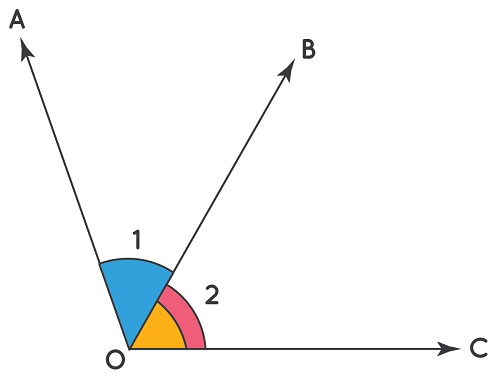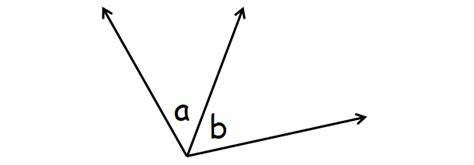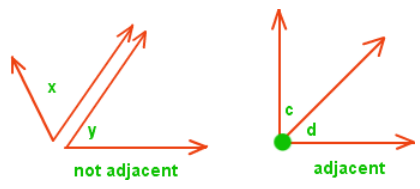Adjacent Angles DefinitionThe term "adjacent angle" in mathematics refers to two angles that do not intersect but have a shared vertex and side. To comprehend the connections between angles and their measures, adjacent angles?which can be found in many geometric forms, including polygons, circles, and triangles?must be understood. It is essential to identify a few basic geometric terms before understanding the meaning of the adjacent angle. An angle is created when two rays or lines that go on forever in opposition to one another cross at a shared location known as the apex. The angle is called after its vertex, and the beams are referred to as its sides. Two angles are said to be adjacent if they have the same apex and side but do not intersect. While the angles' names are given according to their vertices, the shared side is referred to as the arms of the Adjacent angles. For instance, angles AOB and BOC are considered neighboring if they have a shared vertex, O, and a common side, OB. 
Depending on their characteristics, adjacent angles can be grouped in various ways. Based on their measurements, one categorization is commonly used. Two neighboring angles are said to be complementary if their sum of the lengths is 90 degrees. They are referred to as supplementary angles if the sum of their lengths is 180 degrees. They are referred to as uniform angles if their measurements are identical. Adjacent angles can also be categorized based on how they are positioned about one another. Vertical angles are two Adjacent angles on different ends of a transversal line and do not share a shared interior point. Consecutive interior angles are two Adjacent angles on the same side of a transversal line but do not share a shared interior point. In the analysis of triangles, adjacent angles are also crucial. A closed geometry shape called a polygon is constructed of line segments that only meet at their ends. The formula (n-2) x 180 degrees yields the total of the angles' measures in a polygon with n edges. Each angle in a regular hexagon has a measure, which can be determined by dividing the total of the measures by the number of sides. Properties of Adjacent AnglesProperty 1: Adjacent Angles Have a Common Vertex One of their distinguishing characteristics is that adjacent angles have a similar vertex. The intersection of two or more lines or edges is known as a vertex. The vertex is the location where two Adjacent angles come together. Property 2: Adjacent Angles Have a Common Side The fact that Adjacent angles have a shared side is another crucial characteristic. A line segment that joins two vertices is referred to as a side. The common side is the line segment joining the vertices of one angle to another when two nearby angles are involved. Property 3: The Sum of Adjacent Angles is the Measure of the Straight Angle The sum of adjacent angles is always equal to 180 degrees, which is the length of a straight angle. The angle addition postulate is the name for this characteristic. In other words, when two Adjacent angles are positioned side by side, the combined measurements of the two original angles determine the measure of the new angle. This characteristic is quite helpful when attempting to solve issues with determining the measure of an angle. For instance, we can quickly get the measure of the second Adjacent angle using algebra if we know the measure of one of the adjacent angles and the total of the two adjacent angles. Property 4: Adjacent Angles Can Be Complementary or Supplementary There are two types of Adjacent angles: complimentary and supplementary. Two angles are complementary if their sum is 90 degrees and supplementary if their sum is 180 degrees. When handling issues involving angles, considering the connections between nearby angles and complimentary or additional angles is vital. Property 5: Adjacent Angles Can Be Vertical Angles Adjacent angles can also be Vertical angles. When two lines cross, a vertical angle is created along with its opposite. Property 6: Adjacent Angles Can Be Congruent Congruent angles, or angles with the same measure, can also exist between adjacent angles. Two adjacent angles are "congruent adjacent angles" if they are congruent. Property 7: Adjacent Angles Can Be Bisected by a Line A line may also be used to divide adjacent angles. A line that cuts through two Adjacent angles produces four smaller angles, each divided into two halves. 
Uses of Adjacent AnglesWe may better grasp the characteristics of lines and forms by understanding the fundamental geometrical idea of angles. Four angles are created when two lines cross. Two angles are said to be adjacent if they have the same vertex and side but do not overlap. The Latin words "ad," which means "near," and "jacent," which means "lying," are combined to get the English word "adjacent." In many disciplines, including mathematics, physics, engineering, and others, adjacent angles are essential. Angles in GeometryThe area of mathematics known as geometry is concerned with studying the dimensions, locations, and forms of things in space. Because they enable us to comprehend the characteristics of lines and forms, angles are fundamental in geometry. In geometry, adjacent angles are frequently used to demonstrate theorems and resolve issues. For instance, the Adjacent angles are created when two parallel lines cross transversal, called alternative internal angles. Alternative internal angles have the same measure and are congruent. The theorem that asserts that when a transversal crosses two parallel lines, the accompanying angles are congruent is supported by this feature of Adjacent angles. Finding missing angles in a figure is another application of Adjacent angles in geometry. Consider the scenario when we know the measurements of an angle and its Adjacent angles. The connection between nearby angles may then be used to determine the size of the missing angle. Angles in TrigonometryThe study of triangles' side-angle connections is known as trigonometry. Numerous disciplines heavily rely on trigonometry, including physics, engineering, and architecture. In trigonometry, adjacent angles are crucial in understanding how triangles' sides and angles relate. For instance, the tangent is the ratio of an angle's opposing and adjacent sides. The angle formed by the hypotenuse of a right-angled triangle and its adjacent side is known as the adjacent angle. We may use the tangent function to measure an adjacent angle if we know the values of two sides of a right-angled triangle. The cosine function in trigonometry makes use of Adjacent angles as well. The ratio of the adjacent side to the hypotenuse is called the cosine of an angle. We may use the cosine function to measure an adjacent angle if we know the values of two sides of a right-angled triangle. Angles in PhysicsThe study of matter, energy, and their interactions is known as physics. Physics uses angles to explain how objects move, how forces act on them, and other physical phenomena. For instance, the idea of torque is important in physics. Force and the perpendicular distance from the rotation axis to the force's application site are combined to form torque. The force and the lever arm form the angle of rotation. To comprehend the angle of rotation and, consequently, the torque imposed on an item, adjacent angles are required. The research of waves in physics makes use of Adjacent angles as well. The wavelength and frequency of a wave define it. The distance between two adjacent, in-phase points on a wave is known as its wavelength. The wave angle is the angle formed by the wavefront and the wave's direction of propagation. To comprehend the wave angle and the behavior of waves, adjacent angles are utilized. Angles in EngineeringEngineering is designing and constructing machines, systems, and buildings using mathematical and scientific concepts. In engineering, angles are frequently utilized to comprehend material characteristics, forces acting on structures, and other phenomena. For instance, Adjacent angles are utilized in civil engineering to comprehend the forces operating on a structure. A structure experiences a moment when a force is applied, which attempts to rotate the structure. To comprehend the angle of rotation and, consequently, the moment acting on the structure, adjacent angles are required. The study of fluid mechanics is another area of engineering where Adjacent angles are used. The study of fluids in motion and the forces acting on them is known as fluid mechanics. The angle of attack is the angle formed by the surface of an item and the flow direction. To comprehend the angle of attack and the forces exerted on the item, adjacent angles are employed. Angles in NavigationNavigation is the study of planning and managing a vehicle or vessel's travel from one location to another. Angles are frequently used in navigation to determine a vessel's position, speed, and direction. For instance, Adjacent angles are used in sea navigation to determine an object's bearing. The direction from the observer to the item is known as the bearing. The bearing angle is the angle formed between the direction of the item and the true north. To comprehend the bearing angle and the item's location, adjacent angles are needed. The study of celestial navigation also uses nearby angles in navigation. The use of the stars, moon, and planets to locate a vessel is known as celestial navigation. The altitude angle is formed between the celestial object and the horizon. To comprehend the altitude angle and the location of the celestial object, adjacent angles are used. Adjacent Angle in Real LifeOne of the most common examples of adjacent angles in real life is in the construction industry. Architects, engineers, and construction workers use adjacent angles to ensure that buildings and structures are constructed precisely and accurately. For instance, when constructing a building, adjacent angles ensure that the walls are perpendicular to the ground and that the windows and doors are properly aligned. In addition, adjacent angles are also used to design and construct bridges and other structures. Engineers use adjacent angles to ensure that the beams and columns that support the bridge are properly aligned, which is crucial for the safety and stability of the structure. Similarly, adjacent angles are also used in the field of optics. In optics, adjacent angles are used to describe the angle of incidence and the angle of reflection of light rays. This is important in designing optical instruments, such as lenses and mirrors, and in studying how light interacts with different materials. In the field of aviation, adjacent angles are used to describe the angles of attack and the angles of incidence of an aircraft. These angles are important in determining the lift and drag of an aircraft, which are crucial for its stability and performance. Adjacent angles, such as driving a car, are also used in everyday life. When driving a car, adjacent angles are used to determine the direction of travel and the angle of deviation from a straight line. This is important for ensuring the car stays on the road and does not collide with other vehicles or obstacles. Adjacent angles are also used in sports, such as basketball. When shooting a basketball, adjacent angles are used to determine the angle of release and the angle of trajectory of the ball. This is important in determining the accuracy and distance of the shot. Another example of adjacent angles in sports is golf. When hitting a golf ball, adjacent angles are used to determine the angle of the clubface and the swing angle. This is important in determining the direction and distance of the shot. How to Find Adjacent AngleAn adjacent angle in geometry is an angle that has the same vertex and side as another angle. Finding nearby angles is crucial when addressing issues involving angles and geometric shapes. You may use the following procedures to locate nearby angles: Step 1: Identify the Common Vertex and Side It would help if you first determined the common vertex and side the angles share to locate nearby angles. The intersection of two lines is called a vertex, and the line segment that links two vertices is called a side. To accurately identify the Adjacent angles, it is critical to determine the shared vertex and side correctly. Step 2: Establish the Size of One Angle. You can calculate the size of one of the angles once you've located the common vertex and side. Protractors and the information in the issue can be used for this. Ensure that you measure the angle in degrees and note it. Step 3: Use the Properties of Adjacent Angles Adjacent angles have several unique characteristics that can be used to determine the other angle's measurement. The total measurement of the angle comprising both is equal to the sum of the Adjacent angles. Alternatively stated, the outcome should be equal to the measure of the angle that comprises both of them if you sum the measures of two Adjacent angles. Step 4: Solve for the Other Angle You may find the other angle's measurement by using nearby angles' characteristics. To get the size of the second adjacent angle, subtract the size of the known Adjacent angle from the size of the angle encompassing both. Step 5: Check Your Work Double-check your work once you have determined the measurements of the two nearby angles. Make sure the total of the measurements of the two Adjacent angles equals the measurement of the angle comprising both. Look through your work for faults if the sum is not equal. 
Example ProblemFind the measure of the adjacent angle to an angle that measures 65 degrees if the angle containing both measures 145 degrees. Step 1: Identify the Common Vertex and Side The common vertex is where the two lines intersect, and the common side is the line segment that connects the two vertices. The common vertex is not given in this problem, so let's assume point A and the common side is line segment AB. Step 2: Determine the Measurement of One Angle The problem tells us that one of the angles measures 65 degrees. Step 3: Use the Properties of Adjacent Angles The sum of adjacent angles is equal to the full measure of the angle that contains both of them. In this problem, the angle that contains both adjacent angles measures 145 degrees. 145 = 65 + x Where x is the measure of the other adjacent angle. Step 4: Solve for the Other Angle Subtract 65 from both sides: 80 = x Therefore, the other adjacent angle measures 80 degrees. Step 5: Check Your Work Add the measurements of the two adjacent angles: 65 + 80 = 145 The sum is equal to the measure of the angle that contains both of them, so our answer is correct.
Next TopicBalance Sheet Definition
|
 For Videos Join Our Youtube Channel: Join Now
For Videos Join Our Youtube Channel: Join Now
Feedback
- Send your Feedback to [email protected]
Help Others, Please Share









